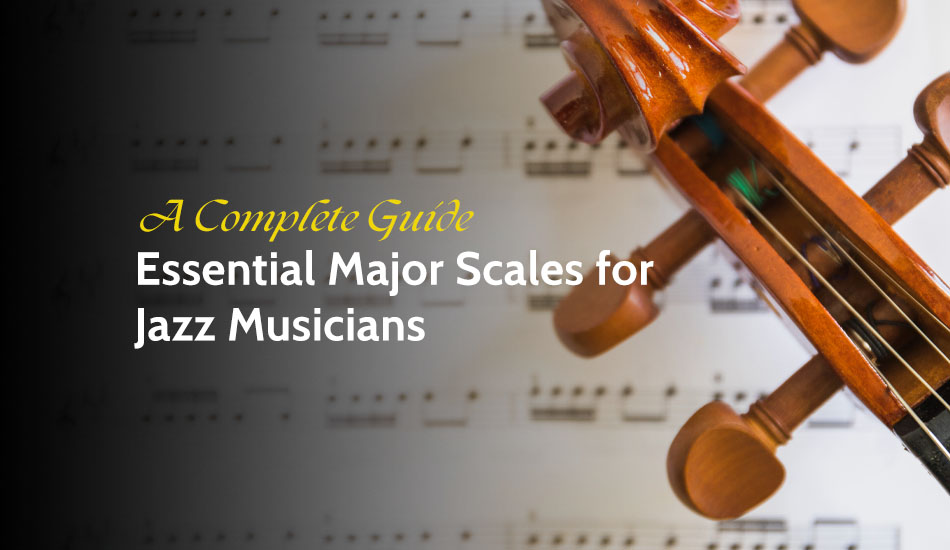If you are thinking about improving your jazz skills and comprehending the specifics of practising jazz standards, the scales for jazz are a must-know. These scales underpin melodies, improvisation, and harmonic movement for every jazz musician and are an essential component for creating any number of improvised jazz lines or chords. Whether you are a pianist or a vocalist, major scales open up more possibilities than you can imagine, make it easier for you to read chords, and bring class to your melodies.
Learn the 12 major scales, find out the best way to practice them, and discover what scale modes are in this easy-to-follow guide while also learning about their uses in Jazz.
The 12 Major Scales (All 12 Keys)
The structure of every major scale is based on a consistent formula of whole steps (W) and half steps (H): W-W-W-W-W-H. This pattern yields a cheerful sound characteristic of the major scale and not of other scales. You want to always feel secure in every key, and when you learn all twelve scales, you are prepared for modulations that take place frequently in jazz compositions.
C Major Scale
The C Major Scale is also the simplest to learn as there are no sharps or flats in this scale. This makes it even better for first-timers to be able to comprehend the scales of jazz.
- Notes: C-D-E-F-G-A-B-C
- Use in Jazz: The C Major Scale is basic for understanding chord formation and basic melodic incantation. Sometimes, it is present in standards such as “So What” and “Autumn Leaves.”
F Major Scale
The F Major Scale teaches you new member one flat (Bb) and contributes to developing your familiarity with the accidentals.
- Notes: F-G-A-Bb-C-D-E-F
- Use in Jazz: This scale is used frequently in the ballads and blues. As for the vibrancy, the F Major Scale is used by many modern jazz singers in their vocal runs.
Bb Major Scale
The Bb Major Scale has flat notes of Bb and Eb. It is a key that forms part of swing and bebop styles of music performances.
- Notes: Bb-C-D-Eb-F-G-A-Bb
- Use in Jazz: It is reckoned as a favorite of brass musicians and, therefore, mandatory for any ornate jazz band, which includes the horn section.
Eb Major Scale
As a key with three flats (Bb, Ab, and Eb), the Eb Major Scale overlays intricate layers to melodies.
- Notes: Eb-F-G-Ab-Bb-C-D-Eb
- Use in Jazz: This scale is best utilized in slow-tempo songs such as jazz ballads and smooth jazz popular songs. Among the best jazz vocalists, there are names who prefer the key of Eb.
Ab Major Scale
The Ab Major Scale contains four flats (Ab, Bb, Db, and Eb), adding a distinctive color to jazz harmony.
- Notes: Ab-Bb-C-Db-Eb-F-G-Ab
- Use in Jazz: A sophisticated key, it’s perfect for advanced players looking to tackle challenging chord progressions.
Db Major Scale (Also C# Major Scale)
The Db Major Scale has five flats (Db, Eb, Gb, Ab, and Bb), while its enharmonic equivalent, C# Major, has seven sharps.
- Notes: Db-Eb-F-Gb-Ab-Bb-C-Db
- Use in Jazz: This scale is characteristic of the modern and modal jazz styles; it is used in compositions which sound somewhat dreamy.
F# Major Scale (Also Gb Major Scale)
This scale is one of the hardest as it has six sharps or six flats when described as an enigmatic equivalent.
- Notes: F#-G#-A#-B-C#-D#-E#-F#
- Use in Jazz: Nevertheless, those who well know this scale can bravely prepare for songs that suddenly start in really intricate keys.
B Major Scale (Also Cb Major Scale)
As with the previous keys, the B Major Scale has five sharps: F#, C#, G#, D#, and A#; there should be extra care when approaching it.
- Notes: B-C#-D#-E-F#-G#-A#-B
- Use in Jazz: It is very useful when performing complex voicings, changes in key in jazz standards, and jazz ballads.
E Major Scale
Four sharps, F#, G#, C#, and D#, are present in the E Major Scale, which belongs to the class of Jazz and contemporary skills.
- Notes: E-F#-G#-A-B-C#-D#-E
- Use in Jazz: This scale is ideal for the players of the guitar and bass who wish to develop chromaticism in their playing.
A Major Scale
The A Major Scale contains 3 sharps: F #, C#, and G#. Owing to its brilliance in tonality, it is preferred for both voice and instrumentals.
- Notes: A-B-C#-D-E-F#-G#-A
- Use in Jazz: This is quite a typical scale for jazz improvisation; it makes solos clear and bright.
D Major Scale
The usage of two sharps, F#, and C#, makes the D Major Scale neither too easy nor too difficult to play.
- Notes: D-E-F#-G-A-B-C#-D
- Use in Jazz: A very general and easy-to-use scale frequently applied to build modal sequences and melodious lines.
G Major Scale
The G Major Scale has one sharp, F# sharp, thus making it one of the easiest scales to use after the C Major Scale.
- Notes: G-A-B-C-D-E-F#-G
- Use in Jazz: It’s a perfect scale to begin with when trying to improvise or study the modes.
Ways to Think of Major Scales When Practicing
To master the scales for jazz, try these methods:
- Practice in Intervals: As for the scales, avoid playing them linearly and spend more time on thirds, fourths, and fifths to learn more about building melodic improvisation.
- Play with Chords: Arrange each scale next to its major and minor chords to see a harmony between them.
- Use Backing Tracks: Practices with play-along accompaniments to mimic real jazz performance scenarios.
What Are Major Scale Modes?
Modes are scales that are basically the major scale but start on different degrees of the scale. For example, the modes of C Major are:
- Ionian (C-D-E-F-G-A-B-C): The standard major scale.
- Dorian (D-E-F-G-A-B-C-D): Widely used in modal jazz.
- Mixolydian (G-A-B-C-D-E-F-G): Essential for bluesy solos.
By practicing in these modes, you learn how to blend scales for jazz into different harmonies, thus coming up with different sounds in the solos.
Conclusion
The entire twelve major scales make for an important course of your growth as a jazz player. These scales for jazz not only teach the technical aspect but also arm you with the capability to be creative in any situation possible.
Take these scales and begin to integrate them into practice and begin to consider them in real jazz pieces. If you are in search of inspiration to use the scale properly, try listening to a modern jazz singer or study the work of the best jazz vocalists to see how the scale looks in action.




